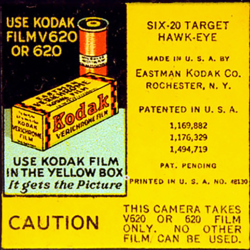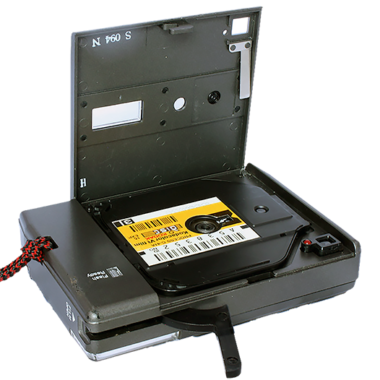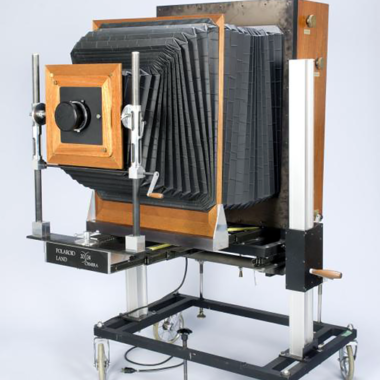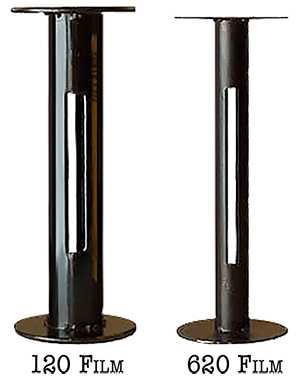Photographic film is a sheet of plastic, coated with an emulsion containing light-sensitive silver with crystal sizes that determine the sensitivity, contrast and resolution of the film. When the emulsion is sufficiently exposed to light it forms a latent (invisible) image. Chemical processes must be applied to the film to create a visible image, in a process called film developing.
PRE-ROLLFILM HISTORY
Beginning in the 1850s, thin glass plates coated with photographic emulsion became the standard medium. Although fragile and heavy, the glass used for photographic plates was of better optical quality than early transparent plastics, and in early years it was also less expensive, so the use of such plates persisted long after the introduction of film.
In the beginning of photography, a lot of different film sizes were used, mainly because the prints were made by means of contact printing 1 to 1, thus, without the use of an enlarging device. The print was just as large as the negative. If you wanted to make a large print, you needed a big camera with a large film format.
THE ROLLFILM APPEARS (CAREFULLY) ON THE SCENE
Eastman Kodak marketed the first flexible photographic roll film in 1885, but this original “film” was actually coated on paper. After exposure, as part of the processing, the image-bearing layer was stripped from the paper base and transferred to a glass support to facilitate printing from it.
Eastman Kodak marketed and produced the first 70mm wide transparent plastic film in 1889. It was made from highly flammable nitrocellulose (celluloid), now commonly known as “nitrate film”. Although cellulose acetate or “safety film” had been introduced by Kodak in 1908, it was not until the 1920s that it began to significantly replace the hazardous nitrate film, which had the advantages of being considerably tougher, slightly more transparent, and cheaper.
THE 35MM FILM APPEARS ON STAGE
Thomas Edison had designed his movie camera in 1889, and needed to standardize on a film width. He slit long rolls of the 70mm Kodak film down the middle, and then cut perforations in both edges for the camera sprocket teeth. And so the 35mm film format was born, albeit for movies. So we owe the 35mm format to a great extent to Edison – in fact 35mm was called the Edison size before.
Oscar Barnack, a designer at Ernst Leitz optics designed in 1925 a small camera that used short lengths of the 35mm movie film. The Leica camera hit the German market and the 35mm format became the standard for still photography. The demand for quality film emulsions drove manufacturers in the US, Japan and Germany to satisfy it. As film emulsions improved, so did image resolution and color reproduction. Many professional photographers were adopting 35mm camera equipment because of their superb lenses and the image quality delivered by modern films.
HOW THE DEVELOPMENT OF THE PHOTOGRAPHIC FILM PROCEEDED
In 1938 color films from Kodak and Agfa made an appearance. Kodachrome was a 12 ISO slide film adapted from movie stock, which had to be sent back to Kodak for complicated processing.
In 1963 Edwin Land caused a sensation with his Polaroid camera and its instantly processed peel-apart print.
Over the years, film manufacturers launched other camera and film formats on the international market. But the small Instamatic 126, the tiny pocket-sized 110 and the infamous Disc had grainy emulsions had poor emulsions and poor image quality. They never enjoyed the success and popularity of the 35mm format.
In fact, 1990’s film emulsions were so good, that some of the biggest film and camera makers banded together to create the Advanced Photo System (APS). The APS format is slightly smaller than 35mm, but offers photographers many useful options. Using IX (information exchange) technology, data recorded during picture taking is transferred to the lab during processing.
116 & 616 rollfilm
Introduced in 1899 and discontinued in 1984

The 116 format dates back to 1899 and was used in early Kodak box and folding cameras. The negatives were big – at 2.5 x 4.5 inches, six frames on a roll. The film stock is 70mm wide: wider than that of 120 film.
During the early days of photography negative size was much more important than now because of the grain size and thus enlargement limitations. Larger negatives meant sharper pictures plus the added benefit of contact printing with is printing photos without having to enlarge it.
In 1932 Kodak introduced two new negative format, 620 and 616, the latter being 70 mm wide. The 616 format was the same as the existing 116 film format but the negative stock was wound on smaller spools (originally metal rather than wood) in order to fit smaller cameras. The first “6” comes from “6 pictures per film”. Later versions were longer and 8 pictures would fit on the film but the name remained the same. Both films were discontinued in 1984.

116 spool, 116 film, 616 film, 120 film, 620 spool
If you respool 120 film onto 116/616 spools, 120 film can be used with cameras designed for 116 and 616, as can 70mm film. (Remember that if you respool 120 film onto 116/616 spools and have it developed at a lab, you must ask for your 116/616 spools back or they’ll be thrown away.)


Spool varieties: 620, 120 in metal, plastic, & wood
120 Rollfilm
Introduced in 1901
 120 film was introduced by Eastman Kodak in 1901 for the inexpensive Brownie Box No. 2 cameras (although the numerical designation 120 came later). It was the main format for amateur photographers and beginners’ cameras like the box cameras.
120 film was introduced by Eastman Kodak in 1901 for the inexpensive Brownie Box No. 2 cameras (although the numerical designation 120 came later). It was the main format for amateur photographers and beginners’ cameras like the box cameras.
The 120 format was originally popular in amateur photography, but after the 1950s, family snapshooters came to adopt 126 cartridge cameras or 35mm film point & shoots; and 120 medium format film became increasingly associated with professional cameras – for example the Rolleiflex or Hasselblad.
Among rollfilm sizes, 120 has had survived the longest, and currently defines “medium format” as it it known today. Its specifications are defined by ISO 732; most recently (as of 2006), by ISO 732:2000. The 620 roll film was the same size, but didn’t have a spool and is discontinued.
35mm and 120 Medium Format Film Comparison
With about 4 times the surface of the 35mm film format, the medium 120 format can be enlarged significantly without losing quality. Artists often use the medium format size for large prints because it has less apparent grain and finer details. Also, it has better tonality (smoother gradations). The biggest and obvious difference in 35mm and 120 Medium Format is the size.
127 Rollfilm
Introduced in 1910 and discontinued in 1995
 The 127 film is a paper-backed roll film, 46mm wide, originally designed to store eight pictures in 4×6.5cm format, this format was smaller than 120 film. It was created by Kodak for their Vest Pocket model – hence 127 was often called Vest Pocket film. Depending on the camera, the image would be a square or rectangular negative. Because enlargements were uncommon during the early usage of 127 film, it was generally contact printed, resulting in 4 x 6.5 cm prints.
The 127 film is a paper-backed roll film, 46mm wide, originally designed to store eight pictures in 4×6.5cm format, this format was smaller than 120 film. It was created by Kodak for their Vest Pocket model – hence 127 was often called Vest Pocket film. Depending on the camera, the image would be a square or rectangular negative. Because enlargements were uncommon during the early usage of 127 film, it was generally contact printed, resulting in 4 x 6.5 cm prints.
Some early Kodak cameras made in 1913 and later included Kodak’s patented Autographic feature, providing the photographer a way to write notations on the back of the film while shooting.
In 1930, during the Great Depression, the camera makers tried to optimize the use of film, and cameras began to appear taking 16 exposures in 3x4cm format on the 127 film, the first one being the Zeiss Ikon Kolibri. In Japan, the 127 film was called “Vest film” (Besuto firumu) until approximately the 1950s, because the film was introduced for the Vest Pocket camera.
127 film gained in popularity through the 1940’s and 1950’s with the introduction of inexpensive Brownie cameras and continued in wide use until the introduction of the 126 cartridge cameras in the 1960’s.

In the 1950s there was a short revival of the 127 film with cameras designed to take 12 exposures in 4x4cm format. Several firms produced high-quality cameras, primarily twin-lens reflexes, in this format. The film was available in colour slide emulsions, and the resulting 4x4cm slides could be projected in a normal projector designed for 24x36mm slides. They were advertised as Superslide.
Kodak stopped producing 127 film in 1995.
620 Rollfilm
Introduced in 1932 and discontinued in 1995

620 film, introduced by Kodak in 1932 and discontinued in 1995, is a roll film that is basically a repackaging of 120 film; it has the same width and length, and completely compatible backing paper. The ‘6’ in 620 was intended to mean that a roll of 620 film provided 6 photos per roll, but by the time Kodak began marketing the film, they had changed the number of photos per roll to 8.
Kodak intended 620 as a replacement for 120 film, and stopped producing cameras for 120 film when the 620 format was introduced. 620 film was never able to gain market share on 120 film likely because professional photographers invested heavily in equipment around the 120 film size.
The first camera to use 620 film was the Kodak Six-20, sold from 1932-1933. The Kodak Brownie Reflex 20, sold from 1959 to 1966, is believed to be the last Kodak 620 format camera made.

Kodak 620 film label from inside the Six-20 Target Hawk Eye
35mm Film Format (135mm Film)
Introduced in 1889

In 1889, Thomas Edison was experimenting with motion pictures and needed long rolls of film, 35 millimeters wide, with holes perforated on the edges so the footage could be driven by sprocket wheels. Thomas A. Edison’s laboratory in New Jersey obtained such by by splitting 70mm roll film. He contacted George Eastman and Kodak initially produced the film on a limited basis. Soon, 35mm film became the standard format for motion pictures.
The 35mm film format was cheap and unused short cut-off bits would certainly be available early on for use in small cameras which were easily portable in comparison the common large-format plate cameras of the time.
Although the first design was patented as early as 1908, it is generally accepted that the first commercially available 35mm camera was the 1913 Tourist Multiple, for both movie and still photography, soon followed by the Simplex providing selection between full and half frame format. Oskar Barnack built his prototype Ur-Leica in 1913 and had it patented, but Ernst Leitz did not decide to produce it before in 1924.
A few years later, small still cameras were manufactured to use this format. In 1934, cartridges were introduced for daylight loading and given the designation of 135. This innovation caused 35mm to become the most popular format of all time and still popular today.


The standard 135 format using 35mm perforated film in cassettes for the still camera has a frame size of 24×36mm – twice the cine frame size. The cassettes typically have enough film for 12, 24 or 36 frames. The 135 format became by far the most widely used photographic film format until the event of the digital camera.

828 Rollfilm
Introduced in 1935 and discontinued in 1985
 828 film was Kodak’s 35mm paper-backed unperforated rollfilm, introduced in 1935. The image size of standard 35mm film was considered “miniature” in the 1930s, but by eliminating the two-sided sprocket holes (a vestige of 35mm film’s movie origins) Kodak could increase 828’s image area by 30% (to 28x40mm). Standard rolls of 828 film yield 8 exposures per roll. A smaller diameter spool allowed for smaller camera designs as well. Kodak’s Bantam camera series used 828 film, and so the size is often known by the “Bantam” name.
828 film was Kodak’s 35mm paper-backed unperforated rollfilm, introduced in 1935. The image size of standard 35mm film was considered “miniature” in the 1930s, but by eliminating the two-sided sprocket holes (a vestige of 35mm film’s movie origins) Kodak could increase 828’s image area by 30% (to 28x40mm). Standard rolls of 828 film yield 8 exposures per roll. A smaller diameter spool allowed for smaller camera designs as well. Kodak’s Bantam camera series used 828 film, and so the size is often known by the “Bantam” name.
Many sources state that 828 film is unperforated; however, true 828 film does include a single perforation per frame on one side of the film, similar to 126 film (but with a different spacing). There may have been some production runs of 828 film that did not include this perforation, but the original 828 film did include a single perforation per frame. This perforation is necessary for correct film advancement in certain native 828 camera models.
Kodak discontinued production of 828 film in 1985.
126 or Instamatic Film
Introduced in 1963

In 1963 Kodak introduced Instamatic cameras that used a plastic cartridge for easy drop-in film loading. The Kodak 126 film cartridge is a roll film magazine for the 35mm-wide film with a paper backing.
It was launched by Kodak in answer to consumer complaints about the complications involved with loading and unloading roll film cameras. With the cartridge film, you don’t have to attach the film leader to a take-up spool. The cartridge simply drops into the camera. Since the cartridge is asymmetric, it cannot be loaded incorrectly. You close the back, wind, and shoot. 126 cameras have a window to show the back of the cartridge, which is printed with the film details and has a small hole revealing the frame number printed on the backing paper.
Around 10 million 126 film cameras were made by Kodak and other companies and it’s likely that family photos from 1965 to the mid-seventies were captured with Kodak 126 film. Cameras were inexpensive and the 126 film cartridge made shooting easy for everyone. Kodak stopped making 126 Instamatic cameras in 1988, and stopped making 126 film in 1999, but some 126 film has been produced by other companies since.


Original 120, 620 and modern 120 film spools with modern 120 exposed color film
220 Rollfilm
Introduced in 1965

220 film is the same width as 120, but with double length (154 cm) and thus twice the number of exposures per roll. ISO 732 also specifies the dimensions of 220 film.
Unlike 120, there is no backing paper behind the film itself, just a leader and a trailer. This allows a longer film on the same spool, but as a result, there are no printed frame numbers for old cameras that have a red window as a frame indicator. (Moreover, light from the window would fog the film.)
Also, since the film alone is thinner than a film with backing paper, a differently positioned pressure plate may be required to achieve optimal focus. Some cameras capable of using both 120 and 220 film will have a two-position adjustment of the pressure plate (as well as a switch elsewhere to adjust winding), while others will require different film backs.
There is only a small choice of 220 film now (2009) available; for example, there is only one kind of black and white film (from Kodak).
The great majority of cameras for 220 film also take 120 film, but at least one model of Linhof and one model of Yashica Mat only takes 220.
110 or pocket Instamatic Film
Introduced in 1972

These 110 film cartridges were launched by Kodak in answer to consumer complaints about the complications involved with loading and unloading roll film cameras. With the cartridge film you don’t have to attach the film leader to a take-up spool and cannot go wrong. The cartridge simply drops into the camera, you close the camera’s back door, wind on and shoot. Even if you open the camera with a half exposed film inside, the precious exposed film is well protected inside the cartridge. And at the end of the film, you don’t have to rewind.
The first Kodak cameras being branded “Pocket Instamatic”. The new pocket-sized cameras became immediately popular, and soon displaced competing subminiature cameras from the market. The 110 film width is 16 mm. The small negative size is half the size of 135 (35mm) film and because it’s small it’s difficult to enlarge and get high resolution scans and the film is often associated with prints and and scans that are grainy and lacking sharpness.
The film is paper-backed; the paper being printed with frame numbers, visible through a small window in the cartridge’s rear; a larger window in the film chamber door shows this frame number window plus a label on back of the cartridge giving film details. Although the format is commonly associated with print film, Kodak also produced Kodachrome 110 slide film until 1982.


110 – 135mm film size comparison
MADE THE 110 FILM POPULAR QUICKLY
After the success of Kodak’s 126 cartridge “Instamatic” cameras, 110 film cartridges were introduced in 1972 to take advantage of improvements in film allowing smaller format negatives.
The format became immediately popular since the cameras were small; hence the name Pocket Instamatic. Cartridges were loaded for 24 exposures with various film types including color negative, black & white, and slide films. Due to the small film area, enlargements from 110 negatives are grainy and not very sharp.

.
Fairly thick film was cut into a disc of 15.8×10.5mm rectangular frames, arranged around the edge of a plastic hub, in a similar manner to View-Master disks. The disc was mounted in a light-proof cassette which could simply be dropped in to the camera. The camera would take a photo, and then rotate the disk 24° for the next shot. The discs had a magnetic strip included, to store information about print settings – allowing duplicate reprints to be made later. The hub carried raised white areas with frame numbers, which were visible through a hole in the cassette.
This format had an advantage over rolled film, in that the negatives stayed flat – needing no pressure plate or rollers, so the film was potentially less subject to image distortion from not being flat in the image plane, less liable to stretching, scratching or emulsion cracking during film advance. However, the small negative proved a greater disadvantage.
The discs were only available for color-print negatives – no other types, such as slide film, were made. As well as Kodak, Konica, Fuji and 3M made disc film – sold under their own names and also as branded by other companies.
Kodak developed special aspherical lenses for the cameras and printing equipment. The flat, roll-less arrangement of the film, meant that disc cameras could be very thin, and the negative size allowed very short focal length lenses (typically 12.5mm), and so lenses did not bulge out far. Most disc cameras were small & thin, with automatic exposure and often automatic flash. However, the complex mechanism in a small space made manufacture difficult, and the film expensive. Once Kodak had established the format, many other companies also made Disc film cameras. Still more – such as the Boots chain in the UK – sold their own brand Disc cameras made for them by others.
kodak disc film
Introduced in 1982 and discontinued in 1999

Kodak introduced the disc film format in February, 1982, along with the cameras in June 1982 (in the US) and September 1982 (in the UK). The intention was to develop the Instamatic idea, of foolproof loading and simple operation, into cameras which would work in all lighting conditions.
The discs contained a flat circle of film with 15 exposures arranged around the edge. Developments in emulsion technology were allowing reasonable quality from very small negatives – at 8×10.5mm, less than 40% of the area of the (already small) 13x17mm frames of 110 film, introduced ten years earlier.
But with an extremely small image area, enlargements are not sharp and tend to be grainy. Disc cameras went out of production in 1990. Most manufacturers stopped making film shortly afterwards – although Kodak carried on with film until 1999.

APS-Advantix Film
Introduced in 1996

The Advanced Photo System (or APS) was introduced in 1996 as a modern replacement for the 110 format. The format was targeted to the broad consumer market for “point and shoot” cameras. The film is housed in a cartridge and the camera handles the loading and rewinding automatically. Once the film was processed, the negatives were reloaded into the cartridge for safe storage. The film width is 24 millimeters and was available in 40, 25, and 15 exposures.
The film is housed in a single-spool 39 mm long plastic. The film surface has a transparent magnetic coating, and the camera uses this information exchange (IX) system for recording information about each exposure. The camera handles winding and rewinding automatically. The slot is protected by a light-proof door and partially exposed films can, in certain cameras, be removed and used later.
Aside from APS being easy to with fully automatic cameras, the main selling point was the ability to choose three print sizes or image formats:
- H – “High Definition” 4 x 7″ (30.2 × 16.7 mm)
- C – “Classic” 4 x 6″ (25.1 × 16.7 mm)
- P – “Panoramic 4 x 11”. (30.2 × 9.5 mm)
The Classic and Panoramic aspect ratios were accomplished with just cropping in on the images. One of the disadvantages of APS film was the film size, which was about 60% smaller than 35mm film. The film is 24 mm wide and the frame is 16.7 x 30.2 mm. Note the two perforations per frame (35mm has 8), and the barcode which tells the printing machine the frame number. Also many film labs needed specialized developing equipment. Most APS cameras (with the exception of some disposable cameras) can record all three formats.
Kodak Advantix APS 200 Color Film
Kodak Advantix APS 200 film designed for zoom cameras and action shots. Discontinued in 2011, Kodak Advantix is becoming quite rare.

SPECIAL FEATURES OF THE APS FORMAT

Unique to APS, the developed APS film is stored in the original cartridge, which guards the film against dust, fingerprints, and damage. Every roll of APS film has a six-digit ID code on the label, which is also stored magnetically and is visible on either end of the processed negative. This ID is usually printed on the back of every individual print. This ID was designed to be an additional convenience both for the photo processor (who can easily match each strip of processed film with its cartridge and each cartridge to a particular customer’s order) and for the consumer, who can easily locate the correct cartridge if reprints are desired.
LARGE FORMAT SHEET FILM
for use in large format photography
 “Large format” refers to any film (and camera) type in which a single frame is 4×5 inches or larger. In comparison, 4 x 5in is 15x the area of a 35mm frame. Other common sizes include 5×7, 8×10, and 11×14. This film is not on a roll, but rather it is in individual sheets (which is why it is also referred to as sheet film) that are loaded into film holders. The holders are then loaded into your camera. So, one exposure is one sheet of film.
“Large format” refers to any film (and camera) type in which a single frame is 4×5 inches or larger. In comparison, 4 x 5in is 15x the area of a 35mm frame. Other common sizes include 5×7, 8×10, and 11×14. This film is not on a roll, but rather it is in individual sheets (which is why it is also referred to as sheet film) that are loaded into film holders. The holders are then loaded into your camera. So, one exposure is one sheet of film.
Large format cameras were some of the earliest photographic devices, and before enlargers were common, it was normal to just make 1:1 contact prints from a 4×5, 5×7, or 8×10-inch negative.
The most common large format is 4×5 inches. Less common formats include quarter-plate 3.25×4.25 inches (8.3×10.8 cm), 5×7 inches (12.7×17.8 cm), and 8×10 inches (20×25 cm). The size of many old 1920s Kodak cameras are 11×14 inches (28×36 cm), 16×20 inches (41×51 cm), 20×24 inches (51×61 cm).
Above 8×10 inches, the formats are often referred to as Ultra Large Format (ULF) and may be 11×14, 16×20, or 20×24 inches or as large as film, plates, or cameras are available. Many large formats (e.g., 24×24, 36×36, and 48×48 inches) are horizontal cameras designed to make big negatives for contact printing onto press-printing plates.

The Polaroid 20×24 camera was (is?) one of the largest format instant cameras in common usage and could (can?) be hired from Polaroid agents in various countries. Many well-known photographers have used this 235 pounds (107 kg), wheeled-chassis Polaroid. Dimensions: 107 x 186 x 75 cm.
The body of the camera is large and the extension of the bellows is significant. It weighs more than 200 pounds. A rack and pinion mechanism is used to adjust the height of the camera. Another one is found in front of the camera to adjust the height of the lens. A large door at the back opens in order to insert the film (a special type made only by Polaroid, such as the Polacolor ER instant color film). There is a digital timer on the side of the camera to determine when it was time to peel the film apart. The camera is supported by a rectangular base on four wheels.

large-fomat-camera-and-holders









